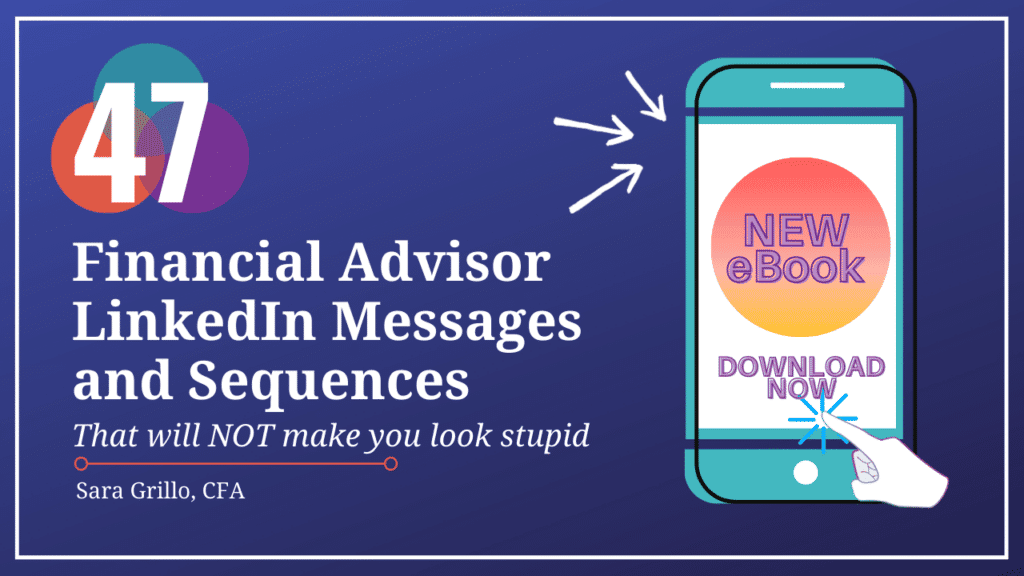Podcast: Play in new window | Download
How much should you give away in a first meeting? The least that you can and still be seen as credible enough to close the deal. But how do financial advisors do that while prospecting? I am about to tell you in this podcast.
For those of you who are new to my blog/podcast, my name is Sara. I am a CFA® charterholder and I used to be a financial advisor. I have a weekly newsletter in which I talk about financial advisor lead generation topics which is best described as “fun and irreverent.” So please subscribe!
Let’s get on with the blog!
Financial Advisor Prospecting: Exchange of Value
I mean, let’s be real. Why would they pay if they can do it themselves?
In my experience I have seen a great deal of overcommunication in these financial advisor prospecting meetings. You could probably communicate about half of what you typically do. But by this I don’t mean hold back items of value.
What I mean is, communicate differently in a way that gets them interested and curious, not feeling like they got their cake and can eat it too.
Interested = they feel that what you offer is relevant to them and can help them
Curious = they are willing to devote at least some amount of time to hearing you talk about it and it won’t be like pulling teeth to sit there listening to you
I will say it differently: the object of the exercise is not to give away so much information that they see you as the most credible financial advisor on earth.
What is the goal of financial advisor prospecting?
Let’s keep in mind the goal of any meeting that a financial advisor has with a qualified prospect:
The goal of the financial advisor prospect meeting is to give away enough information so that they are interested and curious enough to exchange their money for the knowledge you have that they perceive as valuable.
-Sara Grillo, CFA
The first meeting is all about them and you don’t get technical. The process I am going to outline below is for the second financial advisor prospect meeting or even third depending on when you get into their account analysis.
Is there a sure fire way to get the prospect to close during the meeting?
No.
Even having said this, even with the best of execution, all meetings are not going to go your way. Sometimes it’s a personality conflict. Other times they’re just not ready to move forward, or things might not click. How can you prevent this from leaving you with an empty pipeline and even worse, and empty wallet?
That is why you should have an abundance of leads and new prospects interested in talking to you. Financial advisors should try to fill up their sales funnels. In the video below you will learn some ways that financial advisors can get new leads.
How to be great at financial advisor prospecting: 3 easy steps
Set up this strategy before you meet with the prospect and be mentally ready for whatever may happen.
This is a battle. Be ready to fight!
Step #1: Think about what you would barf (overcommunicate) about during the meeting
Examples of questions that you would barf up information all over the prospect about may include:
- When do I take social security?
- What do you think of my portfolio?
- Your view on the market and how to play it?
Step 2: Prepare strategic answers to the questions you typically barf about
Have prepared answers that generate as much confusion as clarity. You never want to give a direct answer here. People will be more attracted to you if you provide an answer that is unclear but makes them think at the same time.
Examples of how to do this during your financial advisor prospect meeting:
They say, “When do I take social security?”
Instead of “probably take it at 62 if you are not working” say something like this, “Let me ask you, have you sat down and mapped out your net cash flow, adjusted for inflation, for the next 5 years?”
They say no.
You say:
“If net cash flow is above a certain amount of your current income, and that percentage is determined on a regular basis according to our actuarial assumptions, then it makes sense to take it earlier. However if it is below that certain percentage, then it makes sense to take it later. Hard to tell without the hard data in front of me.”
Now, this is a simple response and I know that didn’t sound that smart, but I’m not the social security expert, you financial advisors are! You get my point? Say something technical and provide options. But don’t get too technical (example: “that percentage is determined on a regular basis according to our actuarial assumptions”) and be a little bit mysterious.
You want to give them enough so that you seem credible and they get it that a certain process has to be followed, but in no way are you giving them enough that they could do it themselves. You have to give them space.
Remember this key rule:
During the financial advisor prospect meeting, give the client the space to appreciate you by being attracted to the information you provide and how you provide it.
-Sara Grillo, CFA
Throughout your meeting, you have to include an element of mystery because if you spell it all out then they will perceive you as a lower value advisor. Essentially right then and there in the middle of the meeting, you have told them that they do not need to pay you for your knowledge.
Here is another example.
Prospect asks, “What is wrong with my account based upon your analysis?”
You say:
“Geraldine, I reviewed your accounts. On a scale of 1 to 10, I would say your portfolio is at a 6 or 7 in terms of overall health. The biggest opportunities for improvement are:
- There are several mutual funds with an expense ratio that ranks according to our system as what we call “high” or “expensive.” We think that suitable replacements can be found.
- There is a position concentration that we would imagine ourselves unwinding over a period of a few years but trading selectively in accordance with our models.
- I’m sure this is going to be a little bit surprising, but a few of your GRATS are structured in ways that weren’t obvious to me and atypical of how I usually see them. it would be great to speak with your estate attorney and learn about the rationale for setting them up this way.
They say, “Which holdings, can you tell me specifically?”
They say, “Which position was the concentration?”
They say, “Which GRATS were those and what were the other possibilities?”
They say, “Can I have a hard copy of your analysis?”
You say:
“In my experience I have found that these discussions are better kept for when we are formally engaged as advisor and client.”
And then shut up.
- Don’t back down.
- Don’t explain why.
- Do not negotiate.
- Just shut up.
You have them curious and remember that:
Curiosity is one of the greatest human motivators that exists in our psychology.
-Sara Grillo, CFA
When you have them this curious, it’s time to get the deal done. At the point in the financial advisor prospect meeting when curiosity is at its height, you either propose an hourly arrangement where they can meet with you and you provide this for a fee, or they sign the retainer contract. That is how you end it.
Step 3: Practice and log results
Get a journal. Plan out the meeting beforehand. After it is done, assess yourself a score for how well you did what you wanted to do.
At the core of it, financial advisor marketing and sales are about how well you understand the prospect psychologically. Here are some tips for taking the time to do that and doing it intelligently (instead of just barfing up information all over the prospect).
Better self control is what we should all strive for, it is hard but it feels great when you see yourself growing as a human being. I’m someone who is very talkative, gets excited about other people and sometimes can be less strategic in my conversations than would be the best. Not always, but sometimes.
I have learned that silence is value adding. I’ve learned to slow down a bit and use silence. During any meeting, you can always pause for a bit longer than you think before you talk. Before you answer any question, remind yourself that you want to say just enough to get them interested but not one more word than you need to.
And then let them imagine….
Summary of 3 step process
Step #1: Think about what you would barf overcommunicate)
Step #2: Prepare strategic answers to the questions you typically barf
Step #3: Practice and log results
This is how you can be seen as a high value financial advisor and have a great financial advisor prospect meeting.
Sara’s upshot
What’d ya think? Was this helpful?
If yes…
Learn what to say to prospects on social media messenger apps without sounding like a washing machine salesperson. This e-book contains 47 financial advisor LinkedIn messages, sequences, and scripts, and they are all two sentences or less.

You could also consider my financial advisor social media membership which teaches financial advisors how to get new clients and leads from LinkedIn.

Thanks for reading. I hope you’ll at least join my weekly newsletter about financial advisor lead generation.
See you in the next one!
-Sara G
Music is Much Higher by Causmic





